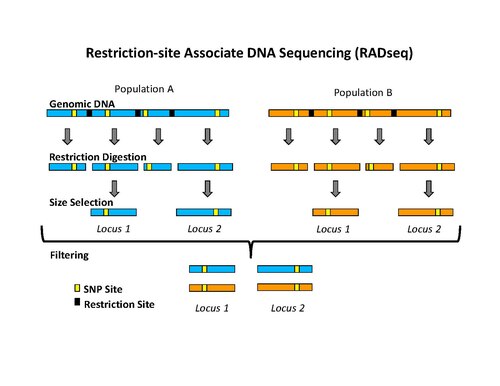Restriction site associated DNA markers

Restriction site associated DNA (RAD) markers are a type of genetic marker which are useful for association mapping, QTL-mapping, population genetics, ecological genetics and evolutionary genetics. The use of RAD markers for genetic mapping is often called RAD mapping. An important aspect of RAD markers and mapping is the process of isolating RAD tags, which are the DNA sequences that immediately flank each instance of a particular restriction site of a restriction enzyme throughout the genome.[1] Once RAD tags have been isolated, they can be used to identify and genotype DNA sequence polymorphisms mainly in form of single nucleotide polymorphisms (SNPs).[1] Polymorphisms that are identified and genotyped by isolating and analyzing RAD tags are referred to as RAD markers. Although genotyping by sequencing presents an approach similar to the RAD-seq method, they differ in some substantial ways.[2][3][4]
Isolation of RAD tags
The use of the flanking DNA sequences around each restriction site is an important aspect of RAD tags.
The initial procedure to isolate RAD tags involved digesting DNA with a particular restriction enzyme, ligating
Detection and genotyping of RAD markers
Once RAD tags have been isolated, they can be used to identify and genotype DNA sequence polymorphisms such as single nucleotide polymorphisms (SNPs).[1][5] These polymorphic sites are referred to as RAD markers. The most efficient way to find RAD tags is by high-throughput DNA sequencing,[5][8] called RAD tag sequencing, RAD sequencing, RAD-Seq, or RADSeq.
Prior to the development of high-throughput sequencing technologies, RAD markers were identified by hybridizing RAD tags to microarrays.[1][6][7] Due to the low sensitivity of microarrays, this approach can only detect either DNA sequence polymorphisms that disrupt restriction sites and lead to the absence of RAD tags or substantial DNA sequence polymorphisms that disrupt RAD tag hybridization. Therefore, the genetic marker density that can be achieved with microarrays is much lower than what is possible with high-throughput DNA-sequencing.[9]
History
RAD markers were first implemented using microarrays and later adapted for NGS (Next-Generation-Sequencing).
ddRADseq
In 2012 a modified RAD tagging method called double digest RADseq (ddRADseq) was suggested.
hyRAD
A study in 2016 presented a novel method called hybridization RAD (hyRAD),[12] where biotinylated RAD fragments, covering a random fraction of the genome, are used as baits for capturing homologous fragments from genomic shotgun sequencing libraries. DNA fragments are first generated using ddRADseq protocol applied to fresh samples, and used as hybridization-capture probes to enrich shotgun libraries in the fragments of interest. This simple and cost-effective approach allows sequencing of orthologous loci even from highly degraded DNA samples, opening new avenues of research in the field of museomics. Another advantage of the method is not relying on the restriction site presence, improving among-sample loci coverage. The technique was first tested on museum and fresh samples of Oedaleus decorus, a Palearctic grasshopper species, and later implemented in regent honeyeater,[13] arthropods,[14] among other species. A lab protocol was developed to implement hyRAD in birds.[15]
